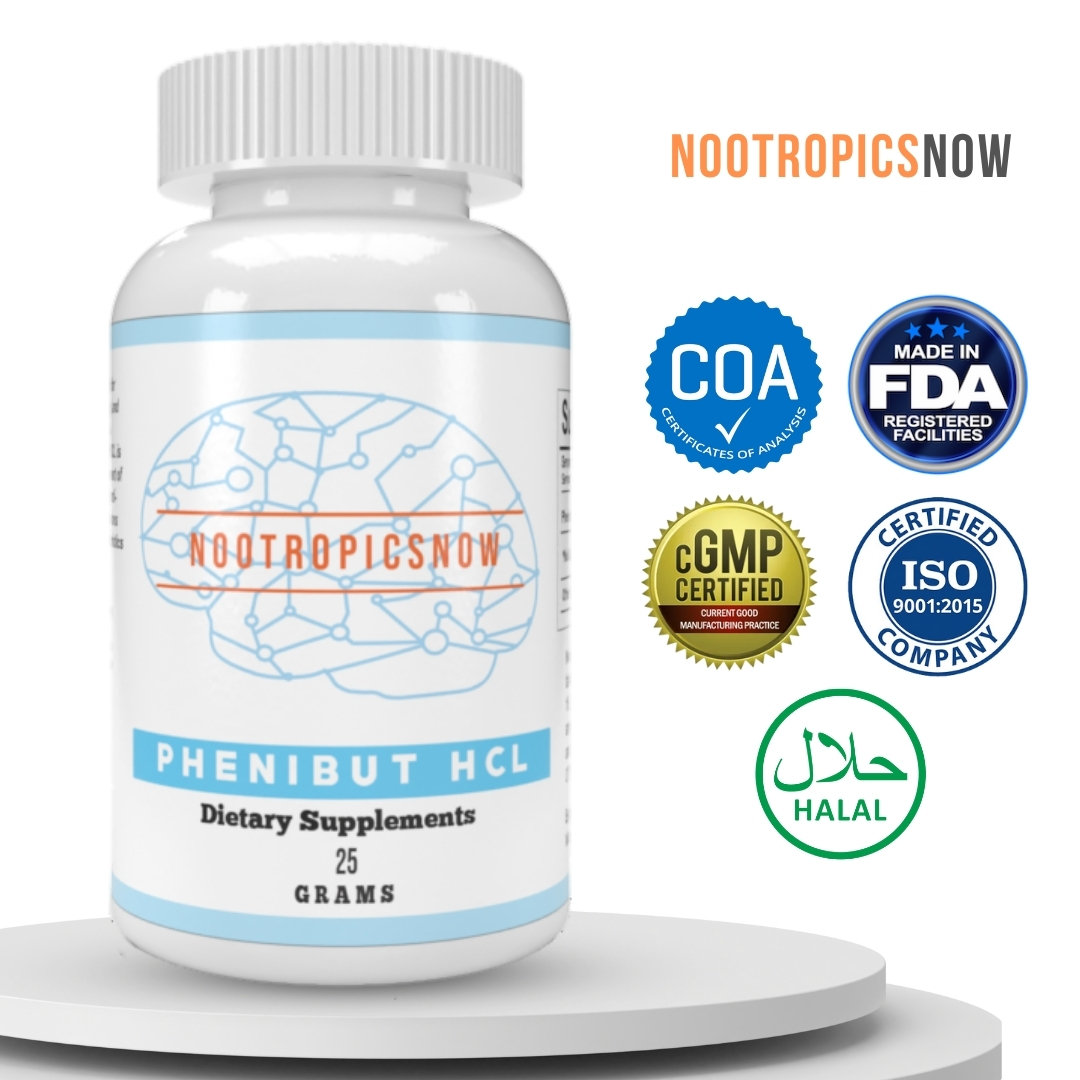Phenibut HCl: Benefits, Uses, & Side Effects

Phenibut HCl: Exploring Uses, Dosage, Side Effects, and Safety

Introduction
Phenibut HCl, or β-phenyl-γ-aminobutyric acid hydrochloride, is a synthetic derivative of the naturally occurring neurotransmitter GABA (gamma-aminobutyric acid). Developed in Russia in the 1960s, it’s used to treat a variety of conditions, including anxiety, insomnia, and post-traumatic stress disorder (PTSD). However, its widespread availability and potential for misuse necessitate a detailed understanding of its effects, proper dosage, potential side effects, and safety concerns. This article aims to provide a comprehensive overview of Phenibut HCl, covering its mechanisms of action, therapeutic uses, risks, and harm reduction strategies.
Understanding Phenibut’s Mechanism of Action
Phenibut’s primary mechanism of action involves modulating GABAergic neurotransmission. Because it’s structurally similar to GABA, it can cross the blood-brain barrier more effectively than GABA itself. It acts as a GABA(B) receptor agonist, meaning it binds to and activates these receptors, thereby enhancing the inhibitory effects of GABA. Additionally, Phenibut HCl interacts with dopamine receptors, particularly at higher dosages, contributing to its anxiolytic and sometimes euphoric effects.
Therapeutic Uses of Phenibut HCl
While primarily prescribed in Russia and some other Eastern European countries, Phenibut has garnered attention worldwide for its potential therapeutic applications. Its documented uses encompass several key areas:
Dosage Guidelines for Phenibut HCl
Determining the appropriate dosage of Phenibut HCl is crucial for maximizing benefits and minimizing risks. Individual responses to Phenibut can vary significantly depending on factors such as weight, age, sensitivity, and pre-existing health conditions. Therefore, it’s essential to start with a low dose and gradually increase it while carefully monitoring effects.
Table: Phenibut HCl Dosage Guidelines
| Category | Recommendation |
|---|---|
| —————— | —————————————————————————————————————– |
| Starting Dose | 250 mg – 500 mg |
| Max Single Dose | 1000 mg (1 gram) |
| Daily Limit | 2000 mg (2 grams) |
| Frequency | No more than 2-3 times per week |
| Spacing | Several days between doses |
| Timing | Evening (for sleep) or during the day (for anxiety) |
| Dose Adjustment | Incrementally increase dose in small amounts (e.g., 250mg) to find the minimal effective dosage |
| Medical Advice | Consult a healthcare professional prior to use. |
Potential Side Effects of Phenibut HCl
Like all medications, Phenibut HCl can cause side effects, which can range from mild to severe. Understanding these potential side effects is crucial for making informed decisions about its use and recognizing when medical attention is necessary.
Risks Associated with Phenibut HCl Use
Phenibut HCl presents several risks, particularly when used improperly or without proper medical supervision. These risks include dependence, withdrawal, overdose, and interactions with other substances.
Harm Reduction Strategies for Phenibut HCl
Given the risks associated with Phenibut HCl, adopting harm reduction strategies is crucial for those who choose to use it. These strategies include:
Legal and Regulatory Status of Phenibut HCl
The legal status of Phenibut HCl varies widely depending on the country. In the United States, Phenibut is not a controlled substance, but it is also not approved for use in dietary supplements. The FDA has issued warning letters to companies marketing Phenibut as a dietary supplement, citing concerns about safety and potential misuse. In some other countries, Phenibut may be available as a prescription medication or may be unregulated.
Conclusion: Responsible Use and Awareness of Phenibut HCl
Phenibut HCl is a potentially useful compound for managing anxiety, insomnia, and other conditions. However, its risks, including dependence, withdrawal, and interactions with other substances, must be carefully considered. By following responsible usage guidelines, adopting harm reduction strategies, and staying informed about the legal and regulatory status of Phenibut, individuals can make informed decisions about its use and minimize potential harm. Always consult with a healthcare professional before using Phenibut or any other medication. Prioritizing safety and awareness is paramount when navigating the complexities of Phenibut HCl.
Dosage and Administration
Recommended Dosage
The appropriate dosage of phenibut HCl depends on various factors, including individual sensitivity, the condition being treated, and other medications being taken. Therefore, consulting a healthcare professional is crucial before starting phenibut HCl. However, general guidelines suggest:
It’s vital to begin with the lowest effective dose and gradually increase it if needed. Exceeding the recommended dosage can significantly increase the risk of adverse effects and dependence.
Administration
Phenibut HCl is typically available in powder or capsule form. Users can take it orally with water or another beverage. To minimize gastrointestinal discomfort, it’s recommended to take phenibut HCl with food.
Cycling
Given the risk of tolerance and dependence, cycling phenibut HCl is strongly advised. Cycling involves taking the substance for a limited period, followed by a break of equal or longer duration. A common cycling schedule is:
This approach helps to minimize the development of tolerance and reduce the likelihood of withdrawal symptoms.
User Experiences and Anecdotes
Positive Effects
Many users report experiencing positive effects from phenibut HCl, including:
These positive effects often lead individuals to use phenibut HCl for recreational or self-medication purposes. However, it’s crucial to be aware of the potential risks associated with such use.
`markdown

View Product
`
`markdown

View Product
`
Negative Effects and Warnings
Despite the positive effects, many users also report experiencing negative side effects, including:
These negative effects underscore the importance of responsible use, careful monitoring, and cycling strategies.
Interactions with Other Substances
Phenibut HCl can interact with other substances, potentially leading to dangerous or unpredictable effects. It’s essential to be aware of these interactions and avoid combining phenibut HCl with certain substances.
Alcohol
Combining phenibut HCl with alcohol is particularly dangerous due to the synergistic effects of both substances on the central nervous system. This combination can lead to:
Benzodiazepines
Benzodiazepines, such as diazepam (Valium) and alprazolam (Xanax), also act on the GABA system. Combining phenibut HCl with benzodiazepines can lead to excessive sedation, respiratory depression, and an increased risk of overdose.
Opioids
Opioids, such as morphine and oxycodone, can also interact with phenibut HCl, increasing the risk of respiratory depression and overdose.
Other CNS Depressants
Combining phenibut HCl with other central nervous system (CNS) depressants, such as barbiturates, antihistamines, and muscle relaxants, can also lead to excessive sedation and respiratory depression.
Legal Status and Availability
The legal status of phenibut HCl varies widely depending on the country and region.
United States
In the United States, phenibut HCl is not a controlled substance at the federal level. However, it is not approved by the Food and Drug Administration (FDA) for any specific medical use. The FDA has issued warning letters to companies selling phenibut HCl as a dietary supplement, citing concerns about its safety and lack of regulatory oversight.
Other Countries
In some countries, such as Australia and some European nations, phenibut HCl is classified as a prescription drug. This means that it can only be obtained legally with a valid prescription from a healthcare professional. In other countries, phenibut HCl may be available over-the-counter or through online vendors.
Availability
Despite varying legal restrictions, phenibut HCl is relatively easy to obtain online from various vendors. However, users should exercise caution when purchasing phenibut HCl online, as the quality and purity of the product can vary significantly. It’s essential to choose reputable vendors that provide third-party testing and certificates of analysis to ensure the product’s safety and potency.
Potential for Abuse and Addiction
Phenibut HCl has a significant potential for abuse and addiction due to its anxiolytic and euphoric effects. Regular use can lead to tolerance, dependence, and withdrawal symptoms upon cessation. Individuals with a history of substance abuse or mental health disorders may be particularly vulnerable to phenibut HCl addiction.
Signs of Addiction
Recognizing the signs of phenibut HCl addiction is crucial for seeking timely help. These signs may include:
Treatment
Treatment for phenibut HCl addiction typically involves a combination of medical detoxification and psychosocial therapies.
Harm Reduction Strategies
For individuals who choose to use phenibut HCl, harm reduction strategies can help minimize the risks associated with its use. These strategies include:
Research and Future Directions
While phenibut HCl has been used for decades, research on its mechanisms of action, therapeutic potential, and long-term effects is still limited. Future research should focus on:
Conclusion
Phenibut HCl is a complex substance with both potential benefits and significant risks. Its anxiolytic, sedative, and nootropic effects have made it popular among individuals seeking to improve their mood, sleep, and cognitive function. However, its potential for tolerance, dependence, and withdrawal symptoms necessitates cautious use, careful monitoring, and harm reduction strategies. Users should consult a healthcare professional before using phenibut HCl and be aware of its legal status and availability in their region. Responsible use, combined with ongoing research and education, is crucial for minimizing the risks and maximizing the potential benefits of this intriguing substance.


